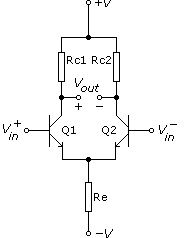Answer the question
In order to leave comments, you need to log in
Why does the transistor open even if its base is supplied with voltage galvanically isolated from the collector-emitter voltage?

Voltages + V and - V are galvanically isolated from the voltage Vin+ and Vin- however, the transistors open
Answer the question
In order to leave comments, you need to log in
This is really a simple question, and the answer must begin with the fact that the bipolar transistor is not turned on by voltage (as you mistakenly assume), but by current passing through the base-emitter junction. Your second mistake is the assumption of complete galvanic isolation of the sources of base and collector currents. Any electric current can only flow in a circuit that has a ring topology. Since the transistor has one common output (emitter) for the collector and base currents, it is clear that complete galvanic isolation between these sources is physically impossible.
Of course, it may seem that the balanced cascade can be controlled from your circuit by connecting a galvanically isolated control voltage source between the bases of the transistors, but this only seems to be. In reality, the base current will simply not flow with such a connection, since its circuit contains two back- to-back emitter junctions. One of them will always be off, there is no base current, and both transistors will be off. This is the "broken base" mode.
To drive these transistors, you will have to apply voltage to the bases relative to the -V point, or the middle point of the collector supply (not visible in your diagram), or any other suitable one that is common to both sources . Only under this condition will a circuit appear for the flow of base currents.
Didn't find what you were looking for?
Ask your questionAsk a Question
731 491 924 answers to any question